Sorry, no content matched your criteria.
Featured Story
When Will Apple Be Worth a Trillion Dollars?

Investors are asking, "When will Apple be worth a trillion dollars?" Not "if."
That's because Apple stock has already shot up 20% this year. It would need another 30% to hit that magic number.
Investors are asking, "When will Apple be worth a trillion dollars?" Not "if."
That's because Apple stock has already shot up 20% this year. It would need another 30% to hit that magic number.
